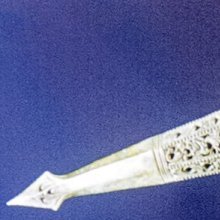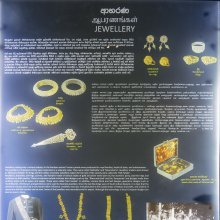Ushi, Uśī: 12 definitions
Introduction:
Ushi means something in Hinduism, Sanskrit, Marathi, Jainism, Prakrit, biology. If you want to know the exact meaning, history, etymology or English translation of this term then check out the descriptions on this page. Add your comment or reference to a book if you want to contribute to this summary article.
The Sanskrit term Uśī can be transliterated into English as Usi or Ushi, using the IAST transliteration scheme (?).
Images (photo gallery)
In Hinduism
Vyakarana (Sanskrit grammar)
Source: Wikisource: A dictionary of Sanskrit grammarUsi (उसि).—Uṇādi afix उस् (us) applied to the root जन् (jan) to form जनुस् (janus) cf. जनेरुसिः (janerusiḥ) Uṇsūtra. 272.

Vyakarana (व्याकरण, vyākaraṇa) refers to Sanskrit grammar and represents one of the six additional sciences (vedanga) to be studied along with the Vedas. Vyakarana concerns itself with the rules of Sanskrit grammar and linguistic analysis in order to establish the correct context of words and sentences.
Biology (plants and animals)
Source: Google Books: CRC World Dictionary (Regional names)Usi in Nigeria is the name of a plant defined with Adansonia digitata in various botanical sources. This page contains potential references in Ayurveda, modern medicine, and other folk traditions or local practices It has the synonym Ophelus sitularius Lour. (among others).
Example references for further research on medicinal uses or toxicity (see latin names for full list):
· Sylva Telluriana (1838)
· Nomenclator Botanicus. (1840)
· Revisio Generum Plantarum (1891)
· Annals of the Missouri Botanical Garden (1995)
· Species Plantarum (1763)
· A grammar and vocabulary of the Nupe language. (1864)
If you are looking for specific details regarding Usi, for example extract dosage, pregnancy safety, diet and recipes, side effects, chemical composition, health benefits, have a look at these references.

This sections includes definitions from the five kingdoms of living things: Animals, Plants, Fungi, Protists and Monera. It will include both the official binomial nomenclature (scientific names usually in Latin) as well as regional spellings and variants.
Languages of India and abroad
Marathi-English dictionary
Source: DDSA: The Molesworth Marathi and English Dictionaryuśī (उशी) [or उंशी, uṃśī].—f (ucchīrṣaka S) A pillow. uśāmpāyatīṃ asaṇēṃ-ubhā rāhaṇēṃ-basaṇēṃ-lāgaṇēṃ To be always at the head and foot of one's bed (to protect, serve, injure &c.); to be about one's bed (and one's path). uśāmpāyatīṃ raḍaṇēṃ To cry or complain unto incessantly.
Source: DDSA: The Aryabhusan school dictionary, Marathi-Englishuśī (उशी).—f A pillow.
Marathi is an Indo-European language having over 70 million native speakers people in (predominantly) Maharashtra India. Marathi, like many other Indo-Aryan languages, evolved from early forms of Prakrit, which itself is a subset of Sanskrit, one of the most ancient languages of the world.
Sanskrit dictionary
Source: DDSA: The practical Sanskrit-English dictionaryUśī (उशी).—Wish, desire.
Source: Cologne Digital Sanskrit Dictionaries: Edgerton Buddhist Hybrid Sanskrit DictionaryUśī (उशी).—(? compare Sanskrit Lex. uśī, wish?), perhaps joy, or energy: in uśī-bahula, Daśabhūmikasūtra 12.10, followed by utsāhabahula, but preceded by udagrībahula and synonyms of this, see udagrī.
Source: Cologne Digital Sanskrit Dictionaries: Shabda-Sagara Sanskrit-English DictionaryUśī (उशी).—f. (-śī) Wish, desire. E. vaś to wish, ī Unadi aff.
Source: Cologne Digital Sanskrit Dictionaries: Monier-Williams Sanskrit-English DictionaryUśī (उशी):—[from uśat] f. wish, [cf. Lexicographers, esp. such as amarasiṃha, halāyudha, hemacandra, etc.]
Source: Cologne Digital Sanskrit Dictionaries: Yates Sanskrit-English DictionaryUśī (उशी):—(śī) 3. f. Wish.
[Sanskrit to German]
Sanskrit, also spelled संस्कृतम् (saṃskṛtam), is an ancient language of India commonly seen as the grandmother of the Indo-European language family (even English!). Closely allied with Prakrit and Pali, Sanskrit is more exhaustive in both grammar and terms and has the most extensive collection of literature in the world, greatly surpassing its sister-languages Greek and Latin.
Prakrit-English dictionary
Source: DDSA: Paia-sadda-mahannavo; a comprehensive Prakrit Hindi dictionaryŪsi (ऊसि) in the Prakrit language is related to the Sanskrit word: Ucchri.
Prakrit is an ancient language closely associated with both Pali and Sanskrit. Jain literature is often composed in this language or sub-dialects, such as the Agamas and their commentaries which are written in Ardhamagadhi and Maharashtri Prakrit. The earliest extant texts can be dated to as early as the 4th century BCE although core portions might be older.
See also (Relevant definitions)
Starts with (+19): Ushi-vashi, Ushidatta, Ushigagnipotogni, Ushij, Ushija, Ushik, Ushika, Ushil, Ushilai, Ushilam, Ushinara, Ushinaragiri, Ushinarani, Ushinaravamsha, Ushingsa, Ushingsha, Ushir, Ushira, Ushirabija, Ushirabindu.
Query error!
Full-text (+77): Ushinara, Ushinarani, Paranci Ushi, Paranci-ushi, Tapus, Ushi-vashi, Ushinaragiri, Vapu, Koba-no-ushi-no-shippei, Pere usi, Izon usi, Cakshus, Taiyaluci, Vapus, Kuntuci, Ucitturral, Ucippalakai, Kara-tiriuci, Ucittontai, Uccimallikai.
Relevant text
Search found 14 books and stories containing Ushi, Uśī, Usi, Ūsi; (plurals include: Ushis, Uśīs, Usis, Ūsis). You can also click to the full overview containing English textual excerpts. Below are direct links for the most relevant articles:
Puranic encyclopaedia (by Vettam Mani)
A Manual of Khshnoom (by Phiroz Nasarvanji Tavaria)
Supplement No. 7 < [Supplements]
Tattvartha Sutra (with commentary) (by Vijay K. Jain)
Verse 2.53 - The lifetime of beings < [Chapter 2 - Category of the Living]
Activities of the All-India Kashiraj Trust (January – June, 1966) < [Purana, Volume 8, Part 2 (1966)]
Dasabhumika Sutra (translation and study) (by Hwa Seon Yoon)
Stage 1: Pramudita Bhumi < [Chapter 2 - Study: Summary of the Ten Stages]
The Malaysian Journal of Medical Sciences
Effects of Malaysian Herbs on Osteoporotic Rat Models: An Review < [v.25(4): 1–151 2018 Jul]

